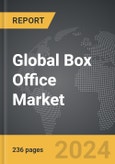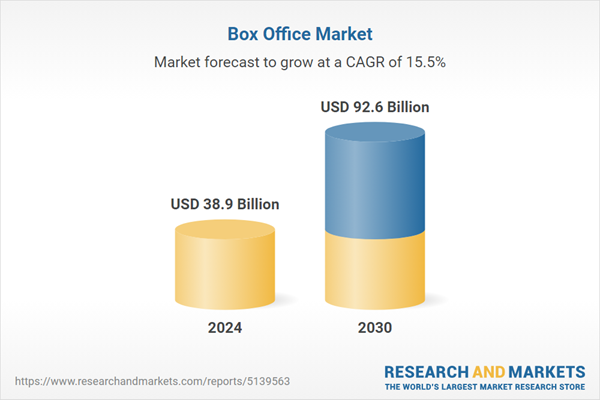Global Box Office Market - Key Trends and Drivers Summarized
How Has the Box Office Landscape Evolved in Recent Years?
The box office landscape has undergone significant changes over the past decade, shaped by a combination of technological advancements, shifting consumer preferences, and the rise of new distribution channels. Traditionally, the box office was dominated by theatrical releases, with film success measured primarily by ticket sales during opening weekends and subsequent weeks in cinemas. However, the advent of digital platforms and streaming services has disrupted this model, offering consumers more flexibility in how and when they watch films. Despite these challenges, the box office remains a vital indicator of a film's commercial success, and blockbuster films continue to generate significant revenue. Many studios are experimenting with hybrid release models that combine limited theatrical runs with immediate availability on streaming platforms. This evolution reflects a broader trend towards a more fragmented and diversified media consumption landscape, where box office performance is just one part of a film's overall financial picture.What Role Do Blockbusters and Franchise Films Play in the Box Office?
Blockbusters and franchise films have become the lifeblood of the box office, often accounting for a substantial portion of annual revenue. These high-budget productions, usually backed by extensive marketing campaigns, are designed to attract large audiences and generate significant box office returns. Franchises such as the Marvel Cinematic Universe, Star Wars, and Fast & Furious have proven to be particularly successful, drawing in repeat viewers and establishing loyal fanbases. These films are not only lucrative in their own right but also serve as tentpoles that support the broader film industry, helping to fund smaller, less commercially driven projects. Additionally, the international market has become increasingly important for the success of blockbusters, with studios tailoring their releases to appeal to global audiences. The importance of these films is reflected in the trend towards sequelization and the creation of extended cinematic universes, which capitalize on established brands and characters to maximize box office potential. This focus on blockbusters has, however, led to concerns about the homogenization of film content, as studios prioritize proven formulas over riskier, original projects.How Are Technological Innovations Shaping the Box Office?
Technological innovations have played a crucial role in reshaping the box office, both in terms of how films are distributed and how audiences engage with them. The transition from physical film to digital projection has streamlined the distribution process, allowing for more efficient and cost-effective releases. Moreover, the rise of high-definition formats such as IMAX and 3D has enhanced the cinematic experience, encouraging viewers to choose the theater over home viewing options. At the same time, the growth of social media and digital marketing has revolutionized how films are promoted, enabling studios to reach global audiences more effectively and generate buzz long before a film's release. Advanced analytics tools now allow studios to track audience engagement in real-time, enabling more targeted marketing efforts and more accurate forecasting of box office performance. These technological advancements have made the box office more dynamic and competitive, with studios constantly seeking new ways to capture and retain audience interest in an increasingly crowded entertainment landscape.What Are the Factors Fueling Growth in the Box Office Market?
The growth in the box office market is driven by several factors directly related to advancements in technology, changing consumer behavior, and evolving industry practices. One of the primary drivers is the increasing globalization of the film industry, which has expanded the potential audience for Hollywood productions and fueled international box office growth. The rise of premium formats, such as IMAX and 4DX, has also contributed to market expansion by offering unique viewing experiences that cannot be replicated at home, encouraging more consumers to visit theaters. Additionally, the proliferation of streaming services has, somewhat counterintuitively, driven box office growth by creating more opportunities for cross-promotion and building anticipation for theatrical releases. This synergy between streaming and theatrical releases is particularly evident in the growing trend of hybrid release strategies, which cater to both at-home and in-theater audiences. Furthermore, advancements in data analytics have enabled studios to fine-tune their marketing strategies, targeting specific demographics more effectively and optimizing release schedules to maximize box office returns. Finally, the cultural shift towards event-driven cinema, where movie-going is seen as a social and communal experience, has reinforced the importance of the box office as a key revenue stream for the film industry.Report Scope
The report analyzes the Box Office market, presented in terms of market value (US$ Thousand). The analysis covers the key segments and geographic regions outlined below.Segments
Genre (Action / Adventure, Comedy, Other Genres).Geographic Regions/Countries
World; United States; Canada; Japan; China; Europe (France; Germany; Italy; United Kingdom; Spain; Russia; and Rest of Europe); Asia-Pacific (Australia; India; South Korea; and Rest of Asia-Pacific); Latin America (Argentina; Brazil; Mexico; and Rest of Latin America); Middle East (Iran; Israel; Saudi Arabia; United Arab Emirates; and Rest of Middle East); and Africa.Key Insights:
- Market Growth: Understand the significant growth trajectory of the Action / Adventure Genre segment, which is expected to reach US$49.0 Billion by 2030 with a CAGR of a 17.7%. The Comedy Genre segment is also set to grow at 14.2% CAGR over the analysis period.
- Regional Analysis: Gain insights into the U.S. market, valued at $9.9 Billion in 2024, and China, forecasted to grow at an impressive 20.7% CAGR to reach $23.9 Billion by 2030. Discover growth trends in other key regions, including Japan, Canada, Germany, and the Asia-Pacific.
Report Features:
- Comprehensive Market Data: Independent analysis of annual sales and market forecasts in US$ Million from 2024 to 2030.
- In-Depth Regional Analysis: Detailed insights into key markets, including the U.S., China, Japan, Canada, Europe, Asia-Pacific, Latin America, Middle East, and Africa.
- Company Profiles: Coverage of major players such as 20th Century Fox Consumer Products, CBS Films Inc., Focus Features, IFC Films, Lionsgate and more.
- Complimentary Updates: Receive free report updates for one year to keep you informed of the latest market developments.
Why You Should Buy This Report:
- Detailed Market Analysis: Access a thorough analysis of the Global Box Office Market, covering all major geographic regions and market segments.
- Competitive Insights: Get an overview of the competitive landscape, including the market presence of major players across different geographies.
- Future Trends and Drivers: Understand the key trends and drivers shaping the future of the Global Box Office Market.
- Actionable Insights: Benefit from actionable insights that can help you identify new revenue opportunities and make strategic business decisions.
Key Questions Answered:
- How is the Global Box Office Market expected to evolve by 2030?
- What are the main drivers and restraints affecting the market?
- Which market segments will grow the most over the forecast period?
- How will market shares for different regions and segments change by 2030?
- Who are the leading players in the market, and what are their prospects?
Some of the 26 major companies featured in this Box Office market report include:
- 20th Century Fox Consumer Products
- CBS Films Inc.
- Focus Features
- IFC Films
- Lionsgate
- Metro-Goldwyn-Mayer Studios, Inc.
- Miramax LLC
- Paramount Pictures Corporation
- Sony Pictures Networks India Ltd.
- The Walt Disney Company
- Universal Studios
- Warner Bros. Entertainment, Inc.
Table of Contents
Companies Mentioned (Partial List)
A selection of companies mentioned in this report includes, but is not limited to:
- 20th Century Fox Consumer Products
- CBS Films Inc.
- Focus Features
- IFC Films
- Lionsgate
- Metro-Goldwyn-Mayer Studios, Inc.
- Miramax LLC
- Paramount Pictures Corporation
- Sony Pictures Networks India Ltd.
- The Walt Disney Company
- Universal Studios
- Warner Bros. Entertainment, Inc.
Table Information
| Report Attribute | Details |
|---|---|
| No. of Pages | 236 |
| Published | April 2025 |
| Forecast Period | 2024 - 2030 |
| Estimated Market Value ( USD | $ 38.9 Billion |
| Forecasted Market Value ( USD | $ 92.6 Billion |
| Compound Annual Growth Rate | 15.5% |
| Regions Covered | Global |









